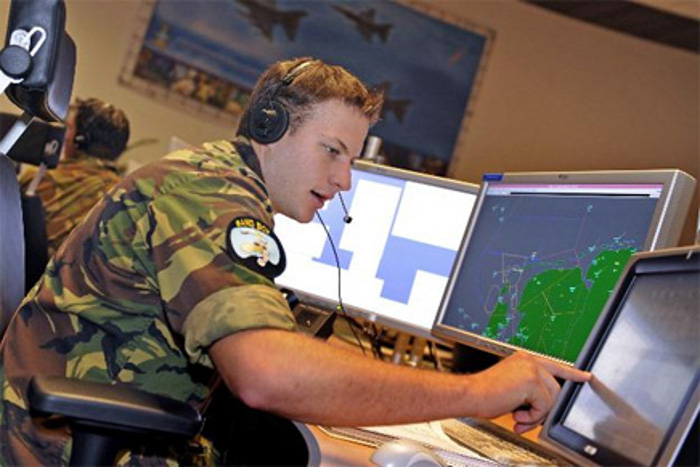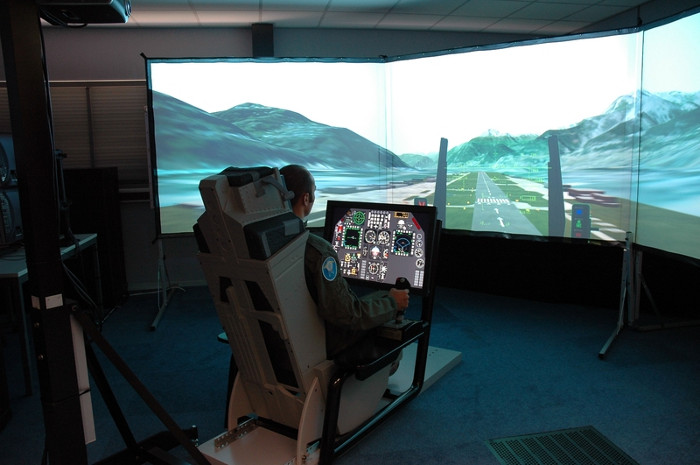F-16 Familiarization Training Simulator
Proper training of fighter and air-traffic controllers of the Dutch Air Operations and Control Station Nieuw Milligen (AOCS NM) is paramount in maintaining a safe and secure airspace above the Netherlands. To replace their real-life F16 operation familiarization training and expand this kind of training, AOCS NM was looking for simulation alternatives. Within a governmental sponsored project Q-tility has performed an explorative V&V study to the usefulness and validity of a distributed training simulation concept for this purpose.
Economical cut backs challenges the Dutch defense organization to look for cost reducing alternatives for their life training. These restrictions also hold for their AOCS NM F16 operation familiarization training performed with real-life F16-BM (dual-seaters), in particular since almost all Dutch F-16BM have been sold. However, for safety reasons the familiarisation training flights had to be performed in a dual seat F-16. A safe and possible more efficient alternative for this kind of training is a distributed simulation, which integrates multiple fix-based F16 simulators, air-traffic generators and AOCS NM fighter and air-traffic controller working stations into a single training environment. Prior to actually investing in such a complex and costly alternative AOCS NM wanted to gain insight into the actual expected benefits and evidence for its return on investment. For this purpose, Q-tility was asked by AOCS NM to explore the domain of validity of such a distributed simulation-based training environment, assess its utility (i.e. training effectiveness and efficiency) and provide them with a transparent and evidence-based recommendation for justifying their future investments in training simulators.

Project approach
In cooperation with members of the AOCS NM School of Air Control, we first performed a quick-scan for the V&V problem to determine the right scope and rigor for the V&V project, given the AOCS objectives, budget, timeframe and major use risk factors. This showed that an explorative V&V study was the best option, means that a domain of validity is determined along with the associated acceptance criteria for the target simulation environment. Based on this outcome we settled the V&V agreement with the AOCS NM.
The V&V project for AOCS NM was organized, managed and executed by tailoring our unique V&V life-cycle model approach for the AOCS NM V&V scope and rigor. Following this life-cycle model we performed an analysis of the context within which the training simulation had to be used. This comprised several visits to the AOCS NM School of Air Control facilities and interactions with subject matter experts (SME) from AOCS NM and the NLR – one of Q-tility’s domain knowledge partners. With this information we applied a goal-based argumentation technique to establish an initial set of acceptance criteria. Next the experimental frame was designed in several iterative phases to support the explorative discovery of acceptance criteria, and experimentally verify their completeness and correctness. With help of our knowledge partner NLR and using their F4S research simulator facility; we implemented and executed this experimental frame in the form of a configurable training simulation test environment and program.

This V&V test environment comprised four F16 simulators, a STAGE scenario simulation, and a AOCS NM MASE working station connected in DIS network. Supported by a F16 instructor pilot we conducted a series of typical familiarization training sessions with instructors and trainees of the School of Air Control. In between the sessions the outcomes were assessed, new acceptance criteria discovered and the V&V experimental frame adjusted.
Results
The V&V results clearly showed that a distributed simulation is a valid and useful alternative for the current familiarization training. More important, this type of simulations provides an even broader domain of validity for AOCS NM training purposes. Reliable acceptability criteria have been developed that can be used as a basis for specifying and accepting the right future simulator. Our V&V approach assured that AOCS got these valuable results, without exceeding budget and timeframe.
Back












